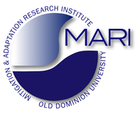Implementing and Monitoring the Sustainable Development Goals in the Caribbean: The Role of the Ocean
Fieldtrip
Chair: Louise Mitchell
The scope of the fieldtrip was to illustrate aspects of living on a SIDS and Interacting with the Ocean. The fieldtrip visited three locations:
- Visit to the site of Serenity Dive in Calliaqua, South Coast.
- Sans Souci beach - major nesting site for leatherback turtles.
- Visit a natural farm at Sans Souci.
At Serenity Dive located in the Calliaqua area on the South coast of Saint Vincent, Vaughn Martin gave an overview of the challenges coastal areas in Saint Vincent are exposed to and summarized the work done in scuba diving courses to raise awareness of the fragility of the marine environment. Serenity Dive is engaged in school projects, especially educating youngsters on scuba diving and having them assist with beach and underwater clean ups. Work has also been done along with the fisher folks within the Calliaqua Area, and 25 of them were certified as part of a sustainable livelihood project. They were to use this new skills to aid in the eradication of the lionfish and in turn sell to nearby restaurants/resorts as a way of earning extra money. The staff at Serenity Dive, is very involved in Lionfish culling and as part of this activity goes to a monthly lionfish fry that earns extra money. They created a local market for for themselves and get get orders for lionfish on a regular basis outside the monthly fish fry.
Mr Martin listed a number of problems faced by them:
- The dumping of plastic oil bottles and bags into the water by the local fishermen.
- The dumping of extra debris that originates from upstream down river when there is heavy rainfall.
- Locally, it is not known where to send valuable lionfish data collected over time and how it is being used.
|
|
At Serenity Dive, Louise Mitchell and Vaughn Martin gave an overview of the challenges coastal areas in Southern Saint Vincent are exposed to and the education scuba divers receive. Scuba divers have a good knowledge of the coastal seas and are good candidates for participating in citizen scientists projects to collect observations. |
At San Souci beach, Robin Hoflund and Louise Mitchell pointed out issues with a large amount of waste deposited on the beach by the ocean. This waste, which to a large extent consists of many forms of plastics originating in different and often far-away parts of the globe poses risks to the leatherback turtles during their brief visits to the beach for nesting. Likewise, activities on land impact the beach and expose the turtles to risks and disturbances. The recent changes in extreme weather events further puts stress on the beach environment.
|
|
San Souci beach on the East coast of Saint Vincent mainland is a major ecologically valuable nesting beach for leatherback turtles. The beach had been cleaned only two months before the visit and plastics and other waste from all over the world had reassembled in a short time. |
|
|
At San Souci beach, the sand available to turtles for nesting is narrowed by erosion, which is expected to increase as sea level increases. The waste deposited on the sand poses a threat to the turtles. |
The visit to the natural farm operated by the Saint Vincent and Grenadines Preservation Fund provided insight in the opportunities this approach to agriculture opens up. It also emphasized the inherent conflict between the nearby conventional farms and the natural farming area, particularly through the wide-spread use of pesticides impacting the natural farming area.
|
|
At the natural farms, Louise Mitchell informed the participants about the approach of the farm to an organic agriculture. The surround traditional agricultural areas pose a challenge to the farm as many of the chemical procedures used there also impact the area of the natural farm. |
This workshop was sponsored by:
 under grant 80NSSC17K0241 |
 |
 |
 |
 |